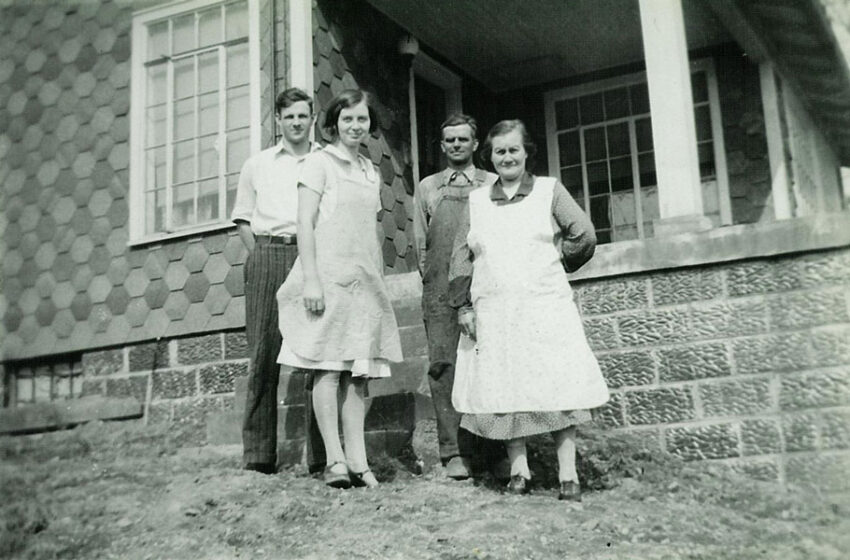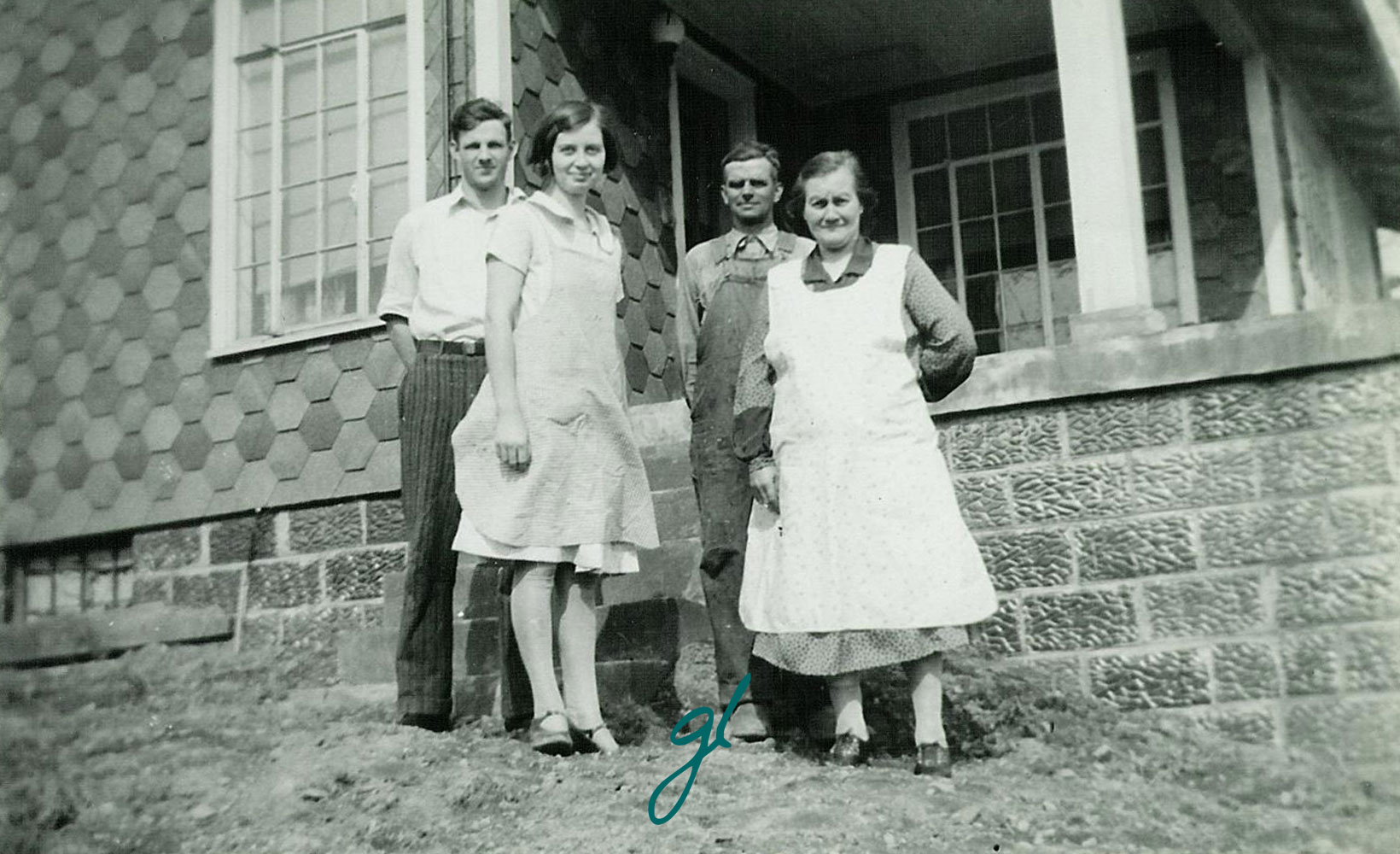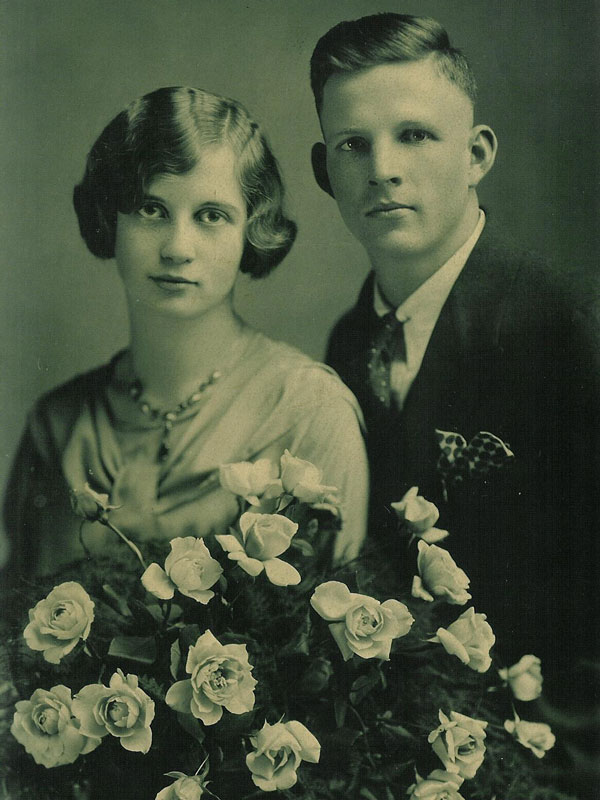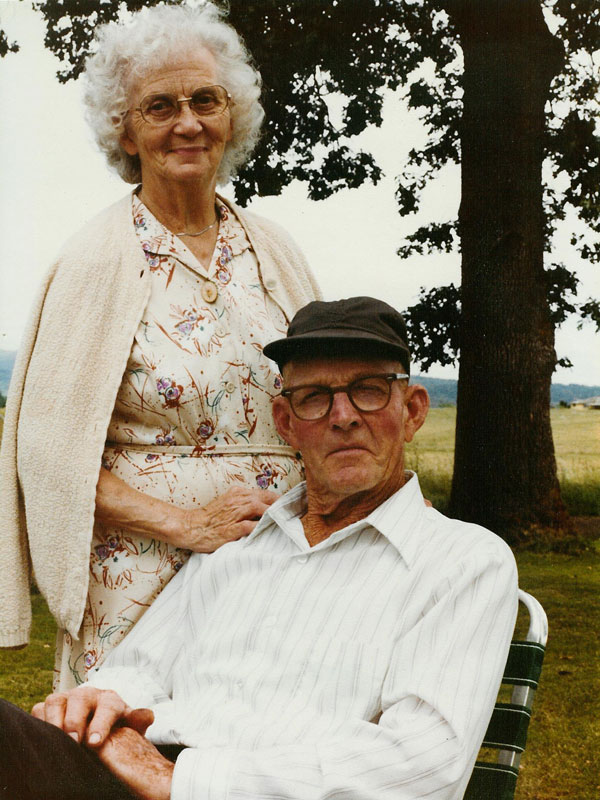The Best Inspirational Historical Fiction About America in the 1920s & 1930s
(This post contains affiliate links. Read my full disclosure.)
Herbert and Alma were married on September 26, 1929. Just over one month later, the stock market crashed. By the time the effects of the Great Depression were felt in Ohio, Herbert was out of work and he and his new bride had to move in with his parents, Marion and May. They hadn’t fared much better–losing their farm and everything they owned except their clothing and household goods.
Herbert and his brothers helped on threshing crews, making $1 a day plus a free noontime meal. Herbert began waiting for work at the steel mill each day. After a year of taking whatever work was available on a day to day basis, he was hired full-time at the steel mill, and Herb was able to purchase two acres where he built a small A-frame house for himself and his growing family.
After years of battling the hard winters, layoffs, and more, Herb and Alma decided to move to Oregon with their six children. Arriving in dry southern Oregon in the summer of 1948, they were disillusioned and turned back to farm near relatives in Iowa. But the winters were still severe, and friends assured them they’d tried the wrong part of Oregon.
So in 1950, Herb and Alma moved their family to Oregon again–this time to the green Willamette Valley. It was there that their third daughter, Mary, met a farm boy named Marvin at the church youth group.
But Marvin wouldn’t have been there at that church in the Willamette Valley if it hadn’t been for generous neighbors of his grandparents, Ernest and Luise. During the eight summers they lived in Kansas after immigrating from Germany, Ernest and Luise had only one crop. Neighbors saw they were literally starving, and paid for their passage on a cattle car to make the train trip to start a new life in Oregon in the fall of 1894.
The stories may sound fantastical when retold in fiction series. But when I read of year after year of failed crops, I remember that poverty and failure didn’t keep Ernest from becoming a successful wheat farmer after he moved to Oregon. When I read about the stock market crash, I remember that Herbert saw the effects of the Great Depression but still had the courage to open a service station when he moved to Oregon. When I read about marriages threatened by the stress of poverty and prohibition, I remember that Herbert and Alma’s marriage of 63 years weathered not only the Great Depression, but the loss of their grandson and only son in a plane accident.
I remember because Marvin and Mary are my grandparents. Herbert and Alma are my great-grandparents. Ernest and Luise, Marion and May, are my great-great grandparents.
When I read books about the Dust Bowl, I know I’m reading the story of my husband’s great-grandparents and great-great grandparents, who rode out the dust storms in Kansas. When I read books set in the Great Depression, I know that I’m reading not only the story of my great-grandparents, but of so many more Americans who persevered through hardships and kept building, kept believing. From the Jazz Age of the Roaring Twenties to the New Deal Era, it was a tumultuous yet definitive time in our country’s history.

North America in the Roaring Twenties, the Dust Bowl, and the Great Depression
Here I’ve collected a variety of inspirational fiction set in north America in the 1920s and 1930s. Some of the books are light, easy reading, while some titles may be read more as a cautionary tale.
The Roaring Twenties Collection by Allison Pittman
1. All for a Song (1922, Missouri)
I wasn’t sure how this book would end–and that had me a bit worried. Even though the storyline is a juxtaposition of the old woman and the young girl, it wasn’t giving anything away. Pastor’s daughter Dorothy Lynn wants to see what’s beyond her hometown before becoming a pastor’s wife. But the temptations of the big city may be wolves dressed in sheep’s clothing. All for a Song left me feeling like there were a few unresolved issues as the storyline came to a sudden close, not the least of which had to do with the real life historical character featured as a revered preacher. (Content warning: drunkenness, sexual references.)
2. All for a Story (1923, Washington, D.C.)
3. All for a Sister (1925, California)
Above the Fold by Rachel Scott McDaniel (1922, Pennsylvania)
I’ve always found books featuring newspaper reporters especially thrilling. This title from debut author Rachel Scott McDaniel is no exception. Elissa Tillman is out to prove to her father–and the world–that women can succeed in journalism without needing to use a masculine byline. She hadn’t figured on her competition for an above the fold headline coming from Cole Parker, the same man who broke her heart. Throw in a mystery to keep you on the edge of your seat, and this is a new release you don’t want to miss.
Halstad House by Christy Martenson (1922, Washington)
A childhood friend who was wounded in the Great War. A “cousin” who is looking for a location for his bootleg whiskey operation. A 4-year-old daughter who charms (almost!) everyone who visits their boarding house. Grace Halstad is not just struggling to make ends meet; Grace is in need of a miracle in her heart as well as her home. A poignant read with characters who come to feel like friends. Appropriate for all ages. (Read my full review of Halstad House.)
Love, Mary Elisabeth by Christy Martenson (1924, Washington)
Her mother is sent away to a sanatorium when she contracts tuberculosis. Her father works in the shipyards. Scared but precocious 11-year-old Mary Elisabeth is stuck on her aunt and uncle’s farm in rural northeastern Washington. Though written for middle-grade, this epistolary novel is a delight for all ages. (Read my full review of Love, Mary Elisabeth.)
Lilies in Moonlight by Allison Pittman (1925, Florida)
A flapper and a veteran. They both have scars–invisible and visible–which shape the way they see others. She loves his mother and he wants her to forgive her own. A slow-moving story that can’t help but sweep you into the world of baseball in the 1920s. (Content warning: sexual references.)
Mistaken by Karen Barnett (1926, Washington)
Rum-runners. Federal agents. And the border town of Port Angeles, Washington. I hadn’t thought much about prohibition in port towns until I read Laurie Burke’s story. Disillusioned with the way the booze has ruined the men in her family, Laurie prays for just one honorable man in her life. Is there any way she can help her brother get back on the straight and narrow? How will she know whom to trust? (Content warning: alcoholism.)
Roaring Twenties Series by Jennifer Lamont Leo
1. You’re the Cream in My Coffee (1928, Illinois)
A common post-war scenario: her boyfriend didn’t come back from the war (did he?) and her brother came back wounded. Marjorie tries to recreate her life and find herself–and maybe true love. You’re the Cream in My Coffee is also a fascinating glimpse into upscale retail in Chicago in the 1920s! I couldn’t put it down.
2. Ain’t Misbehavin’ (1929, Illinois)
This glimpse into the Jazz Age and speakeasies often made me want to shake some sense into Dot and her on-again-off-again hero. But Ain’t Misbehavin’ imparts some important truths about relationships and forgiveness. It also provides a close-up look at what business owners may have faced as the Great Depression loomed.
Vintage National Parks Novels by Karen Barnett
These exquisite covers enclose enchanting stories! I love the way Karen Barnett uses historical facts and real people throughout her books, lending not only authenticity but education to her tale. The facts are outlined in the Author’s Note afterward, so you’re sure of what was fact and what was fiction. (Each storyline stands alone, so the novels do not need to be read in order.)
The Road to Paradise (1927, Washington)
In The Road to Paradise, Karen Barnett takes us to Mt. Rainier National Park as it was in the Twenties, painting a vivid picture of the glorious scenery while introducing us to fictional characters who steal our hearts. A must-read for anyone who enjoys the work of Gene Stratton-Porter or simply loves vintage fiction woven around God’s creation.
Where the Fire Falls (1929, California)
It took me a few chapters to fall in love with Flapper artist Olivia Rutherford. But I quickly discovered there was more to this character than her bobbed dyed hair and painted face. (I think our hero Clark felt the same way.) Karen Barnett has created a masterpiece of mystery and intrigue that draws the reader into the story and–while giving lovely glimpses through glowing descriptions–makes them want to see the scenes of Yosemite for themselves.
Ever Faithful (1933, Wyoming)
Step back in time to the days when Yellowstone National Park was known as “Wonderland” and the Civilian Conservation Corps provided young men with employment during the Great Depression. Meet a young ranger named Teddy Vaughn, a ranger’s daughter named Elsie Brooks, and a CCC recruit from Brooklyn named Nate Webber–two of whom have something to hide. Karen Barnett weaves powerful lessons in leadership, friendship, and forgiveness into this vintage mystery with a surprising plot twist. (Ever Faithful focuses more on the characters and less on the details of the grandeur of the scenery than the first two books.)

Hidden Places by Lynn Austin (1930)
Is the family orchard cursed by death? Widow Eliza Wyatt has nowhere else to go with her three children. But she doesn’t know how she will manage Wyatt Orchards on her own come spring. Until a hobo journalist lands on her doorstep. The intensity of the plot is relieved by revisiting the past as each of the main characters tells their story. A riveting tale that covers some very difficult topics. But then there’s redemption! (Content warning: seduction, unwed pregnancy, physical and verbal abuse, drownings.)
Pearl Spence Novels by Susie Finkbeiner
1. A Cup of Dust (1934, Oklahoma)
Pearl Spence is the sheriff’s daughter. She’s confident in the love of her family, despite the desperate times their community is facing. But then a man named Eddie comes to town knowing her name and threatening that he knows a secret about her. A Cup of Dust is the gripping story of a 10-year-old girl’s fight against fear and search for identity, set against the forlorn backdrop of the Dust Bowl. (Content warning: death, murder.)
2. A Trail of Crumbs (1935, Oklahoma)
3. A Song of Home (1935, Michigan)
American Dreams Series by Jan Cline
1. Heaven’s Sky (1935, Kansas)
Tiny graves. Family secrets. A grieving mama. A reverend she can’t believe and a drifter she must trust. Clarissa is searching for hope for her marriage and healing for her family amid the devastation of the Dust Bowl. On each page of Heaven’s Sky, I could nearly feel the layers of dust coating everything Clarissa touched, and almost taste the grit in the scant food she had to feed her children. (Content warning: child loss, unwed pregnancy.)
2. The Pruning (1935, Washington)
Jan Cline dove deep into character development in this second book in the series, making us feel every emotion of anger and worry, fear and distrust. With beautiful parable-like references to pruning and forgiveness, this is a tale that makes you long for redemption, not only in the book, but in your own life.
3. All My Goodbyes (1941, Washington)
This third book in Jan Cline’s American Dream series can be read as a stand-alone novel, since All My Goodbyes shifts the focus to a new set of characters with the advent of WWII. Journey along with Martha as she struggles to move beyond long-held fears and to trust the Lord with those she loves. Don’t miss the afterward to find out how much of this story is based on fact! (Content warning: drowning.)
On Shifting Sand by Allison Pittman (Oklahoma)
The topic of infidelity made this a challenging read even without the desperation and death of the Dust Bowl. Allison Pittman takes the reader on a journey into the heart of a woman whose very soul is parched by the drought of dissatisfaction. Nola is a pastor’s wife who makes seemingly small but reckless decisions that throw her headlong into the path of temptation. Will redemption come with the rain? (Content warning: prevalent theme of adultery, non-graphic mentions of adulterous acts.)
The Rosey Corner Series by Ann H. Gabhart
1. Angel Sister (1936, Kentucky)
Ease yourself gently into the town of Rosey Corner, where you’ll soon become engrossed in the story of 14-year-old Kate Merritt and an abandoned little girl named Lorena Birdsong. With chapters that alternate between the point of view of Kate and her parents, we’re often taken back in time to her parents’ youth. The storyline will captivate you, while the themes of forgiveness and family relationships may challenge you. Definitely a series I want to finish reading! (Content warning: WWI PTSD, alcoholism, drowning, and fire.)
2. Small Town Girl (1941, Kentucky)
3. Love Comes Home
Van Buren and DeLuca Mystery Series by Rachel McMillan
1. Murder at the Flamingo (1937, Massachusetts)
Regina Van Buren fled the expectations of her family’s society life. Hamish DeLuca attempted to run away from the anxiety that has plagued him all his life. The two met through their work for Hamish’s cousin Luca and his dazzling new night club, The Flamingo. A book for those who like their mysteries to be seasoned with a dash of romance–not to mention delicious descriptions of Italian pastries (you’ll need to eat cannoli while reading Murder at the a Flamingo!). A bit of a Nick and Nora flavor, which will be enjoyed by fans of The Thin Man, but this series errs on the side of caution rather than creepiness, which I for one appreciated. (Note: though written by a Christian author, the book/characters do not discuss faith or God. Content warning: alcoholism, murder.)
2. Murder in the City of Liberty (1940, Massachusetts)
Visit my Goodreads shelf featuring historical fiction from the twenties and thirties!
Thank you to authors Jan Cline, Susie Finkbeiner, and Rachel Scott McDaniel for providing digital review copies of their novels for this post! Thanks to NetGalley for the ARCs of Karen Barnett’s books. Opinions are my own.





I read a series of books back in the late 90’s about a young lady who moved to the Pacific Northwest from the east. I believe it was set in the early 1900’s. The main character befriends people who live in the surrounding woods and marries the son of the people living in the big house on the estate. I can’t remember title or author. Maybe someone knows 😃
Thanks for including my Rosey Corner books. Love the pictures you posted with the piece. Pictures from earlier times seem to mean so much more than those we have today because there weren’t that many of them. I only have a precious few of my parents when they were children.
Thank you, Ann, for writing such a delightful book! I can’t wait to read the rest of the series.
I agree–those vintage photos are precious. I’m so grateful for the work my grandmother, aunt, and mom have done in compiling and scanning so many old family photos. It’s my goal to do the same with the photos from my husband’s side of the family!
Really great list of books. I especially liked Susie Finkbeiner’s series. Some on your list are now on my TBR wishlist. I just finished Wings Like A Dove by Camille Eide, set in 1933. It was wonderful — I highly recommend it as well.
Thank you, Beckie. I’ll add Wings Like A Dove to my TBR list!